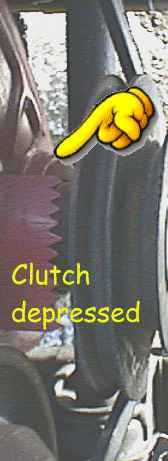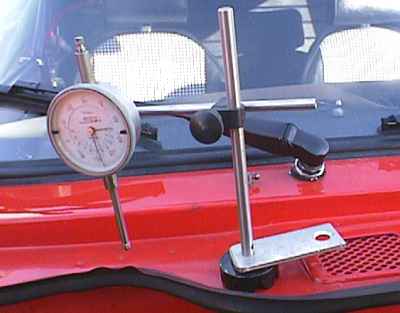|
|
|||||||||
![]()
Well here's another one. Another subject lacking useful documentation on the net. Hence, the reason behind these pages, let everyone see what they're in for when dealing with thrust bearings and the Triumph 1500 series engine.
Thrust Bearings on the 1500 series engine are infamous for failing. There are a lot of sites that will tell you the trials and tribulations of failed bearing. Well here are a few photos of what this mess all looks like to go with the words.
|
 timing mark indicator |
.....Well I just checked
my own little screamer...... Oh man. Look at the photos! ...Notice the gap between the timing mark indicator and the edge of the pulley. I measured the free end play three times. The average says I have roughly 0.104" of fee movement. Time to change the bearings! The standard bearings (as I measured them) are 0.090" thick. the thrust bearings can be purchased in 0.005", 0.015", and 0.030" thickness over sizes to take up (setup) proper end float. |
This is a must have tool. Not just for this job, but checking valves, and front wheel bearing end float are just a couple of other uses. This is my dial indicator with a magnetic base and adjustable arm.
|
 |
In the first two photos you can just see the tip resting against the pulley at the bottom edge of the smaller v-groove of the lower pulley. I went ahead and bought three sets of thrust bearings. One set of each of stock (0.090"), 0.015" over and 0.030" over, thick sets. With a range of 0.097" to 0.104" as my measured free play, I'm guessing (hoping!) that one has simply dropped out. At 0.104" of free play, subtract the stock thickness of 0.090" says I have 0.014" extra free play to try and make up for. Looks like I'll need to pick up a set of 0.005" oversize as well. (...figures...the one size I didn't get) So IF.... one has fallen out, then one 0.005" oversize and one stock, will correct for the amount of free play I have in mine. ...... but who knows...this engine may already have two 0.030" in it... check back to see what I find when i finally pull the lower end.
I finally got in there and replaced the bearings. Well I was right! One had simply fallen out. I was able to slip in an 0.005" oversize, but couldn't seem to get the second one in. So I installed one 0.005" oversize at the rear (fatten up the one that wears and falls outs) and one new standard size in the front. When I went back and measured the freeplay it was now at 0.004". We'll see how long they last. I'm going to keep checking them every hundred miles or so and see how they fare.
|
|
![]()
|
Here's a shot of the gauge in place on my 1975 Spitfire Whitey |
|
|
|
|
©1987-2010
All material copyright© Teglerizer 1996-2008last edited
3/15/08

hits since last reset